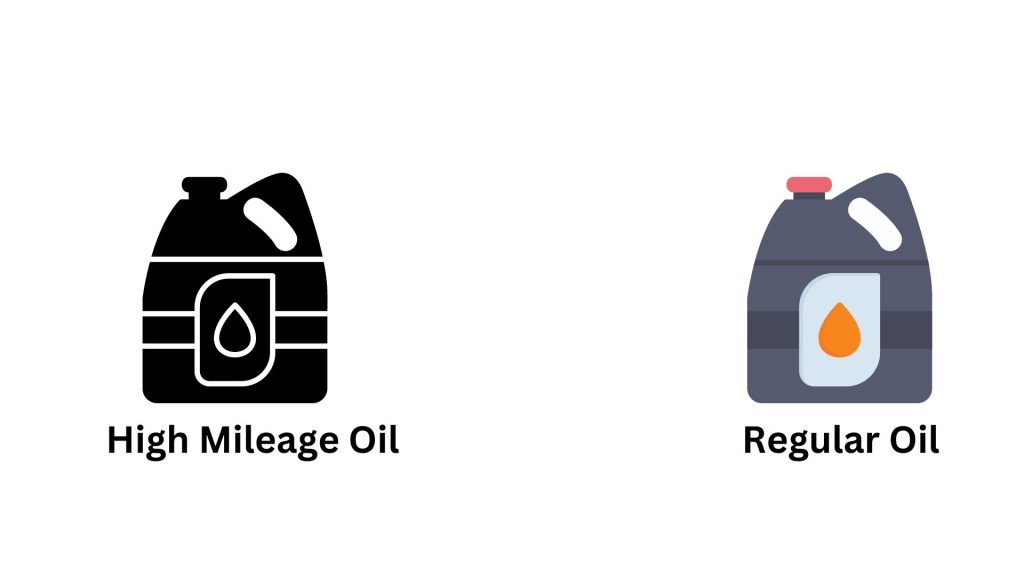Regular oil is a motor oil that lubricates the moving parts in an engine. While regular oil can be synthetic in nature, many people associate this classification with petroleum oil that originates from crude oil that has been refined. You can add regular oil to every vehicle regardless of the type, brand, or age. High-quality motor oil includes additives that fight oxidation, prevent corrosion, and clean the passageways, extending the engine’s lifespan in the process.
High-mileage oil is similar to regular oil. However, it has additives that specifically target old engines. Motor oil is designed to prevent the moving parts in an engine from coming into direct contact with one another.
It clings to the metal surfaces in a thin film. Metal surfaces are not as smooth as they appear. They are rugged, with numerous peaks and valleys. Those peaks and valleys become deeper and more pronounced as the engine ages.
If you ignore them, the metallic components in question will wear out, and the engine’s efficiency will deteriorate. You expect motor oil to prevent this outcome by coating the metallic surfaces with a thin film that covers the crevices.
But regular oil tends to fall short because of the wear and tear older vehicles have suffered. This is where high-mileage oil shines. It performs the following functions:
- High-mileage oil has seal conditioners that rejuvenate seals.
- It slows the rate of wear and tear by reducing friction between moving parts in old engines.
- It removes the sludge and grime that accumulates in old engines.
- It combats leaks.
Regular motor oil has plenty of beneficial additives. But they are less effective in old engines with hardened and decayed seals and gaskets. You need the special detergents, antioxidants, and conditioners in high-mileage oil to resolve the faults in an old engine.
Do You Need High Mileage Oil?
Cenex associates the term ‘high-mileage’ with engines that exceed their warranties. It specifically mentions vehicles with 60,000 or more miles. Most mechanics target cars with at least 75,000 miles.
However, it depends on the driving conditions. For instance, 75,000 miles on a highway are not as taxing as 75,000 miles in a city. 75,000 city miles tend to strain the vehicle because you keep starting and stopping.
A vehicle with 80,000 miles that drives in the city may manifest more significant wear and tear than a similar vehicle that drives 150,000 miles on the highway. Ultimately, what you see when you inspect the engine will determine the oil you use.
You can tell that an engine requires high-mileage oil because the rubber that makes up the gaskets and seals has shrunk and hardened. You may also notice engine oil on the driveway whenever you park, revealing a leakage.
Admittedly, this question isn’t quite as important as people think. High-mileage oil doesn’t benefit new engines because they don’t have the problems the oil was designed to resolve. However, you won’t harm the new engine by adding high-mileage oil.
The only risk is using regular motor oil in an old engine when it requires high-mileage oil. High-mileage oil will reduce oil consumption and protect the engine from further damage in a vehicle with 75,000 miles or more.
Is It Safe To mix High Mileage Oil With Regular Oil?

It is safe to mix high mileage oil with regular oil because
- For the most part, regular oil and high-mileage oil is the same. High-mileage oil has special additives that rejuvenate gaskets and seals in older engines. However, most motor oil types and brands have the same base ingredients and additives. Apparently, the American petroleum industry encourages compatibility between motor oil brands and types. They want to increase the options drivers have at their disposal.
- That being said, manufacturers are pretty secretive about their motor oil formulations. This gives them an advantage over their competitors. Therefore, you can’t assume that your vehicle will respond positively to a blend of high mileage and regular oil. This shouldn’t stop you from experimenting. But you should do so knowing that your actions may backfire.
- However, for the most part, this practice is safe. The manual will have the final say. Follow the manufacturer’s recommendations. Some vehicles use proprietary technology that requires a unique brand of oil. Therefore, using the wrong oil, or even a blend of high-mileage and regular oil, may produce disastrous results. Don’t take any chances unless the manufacturer gives you the green light.
- Consult a mechanic if you have questions. They can inspect your engine to determine whether a high-mileage/regular oil blend is detrimental to the vehicle’s operations.
- You can experiment with each oil type individually. You can switch from regular oil to high-milage oil for a short period to determine whether or not it benefits your car. And if you don’t like what you see, feel free to switch back. Some people are convinced that switching from regular to high-mileage oil prevents you from changing back. But that is not true. You can switch between oil types if they all fit the engine’s specifications.
- Use your next oil change to switch between oil types. The mechanic may ask a few questions about your driving habits, but only if they are concerned about the switch. Otherwise, you can trust them to remove the old oil before adding a compatible replacement. You should hire a mechanic to perform this task because they can safely dispose of the old oil.
Understanding The Potential Effects Of Mixing Different Oil Types And Viscosities
Mixing different oil types is mostly harmless. However, you should keep two factors in mind:
- You can’t improve regular oil by adding high-mileage oil.
- Adding regular oil is more likely to dilute high-mileage oil’s benefits.
Unless you have the knowledge and expertise to create a unique blend that combines the properties of two different oil types, you don’t gain anything by mixing oil types. In fact, you could make things worse. With viscosities, you have even less room to breathe. The viscosity matters because it affects the motor oil’s ability to flow through the engine. If the oil is too thin, it won’t lubricate the engine’s moving parts.
But if it’s too thick, it won’t reach every corner of the engine that needs motor oil. By mixing different viscosities, you may create a blend whose thickness (or lack thereof) harms the engine. The only exception is oil types whose viscosities are closely matched.
Recommended Approach For Mixing Oil Types
- Pay attention to the viscosity. It affects the oil’s response to variables like temperature. Try to find oil types and brands with the same viscosity.
- You can mix regular and synthetic oils. However, synthetic oil is superior because it has fewer impurities. Combining the two will dilute the synthetic oil’s capabilities. It may also change the workings of the additives in the synthetic oil. Therefore, in some cases, you might be better off mixing regular oil with regular oil and synthetic oil with synthetic oil.
- Mixing oil from different brands is risky because you don’t know their formulations. However, you can eliminate some of the risks by using API-certified oil.
- Try to limit these blends to emergencies. You can add a different motor oil type or brand when your vehicle is stranded on the roadside because of low oil levels, and the only motor oil at your disposal is a different type or brand. But you shouldn’t make a habit of this practice. And if you think you made a mistake, talk to an expert about flushing the system and adding the correct oil type.

